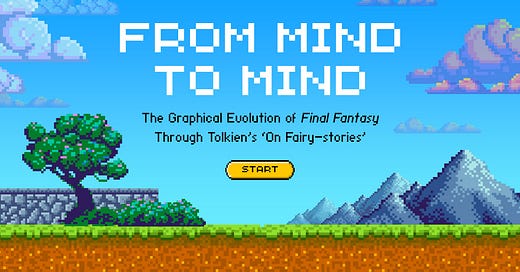From Mind to Mind [Conference Presentation]
the Graphical Evolution of Final Fantasy through Tolkien’s “On Fairy-stories”
This paper has been presented at:
March 29th, 2024 | PCA National Conference
Abstract
Tolkien’s essay “On Fairy-stories” outlines the author’s theory of Fantasy and includes Tolkien’s thoughts on the appropriate medium for such artworks: “Fantasy is a thing best left to words, to true literature. […] Literature works from mind to mind and is thus more progenitive. It is at once more universal and more poignantly particular.” Language as medium allows the reader/hearer to participate in the act of subcreation through imaginative generation of the Secondary World—each word chosen by the author activating in the encountering mind a complex matrix of associations with both individualized and “Platonic” examples of the referent. In comparison Tolkien identifies a tendency for visual representations of Fantasy to overwhelm these faculties, in essence dominating the viewer’s encounter with the Secondary World. This poses interesting questions for the application of Tolkien’s theory to many current examples of Fantasy in primarily visual media such as films and video games.
Final Fantasy is a series of JRPGs (Japanese Role-Playing Games) consisting of 16 major titles released for various video game consoles between 1987–2023. Applying Tolkien’s theory to a formal analysis of the changing graphical qualities of this series suggests a more nuanced understanding of what mediums are capable of inviting the kind of imaginative generation Tolkien describes and what may count as “true literature.”
Building on the work of MacLeod and Smol, utilizing the concept of “Visual Indeterminacy,” and combining the tools of art theory with an understanding of early JRPG graphics as pictographic/ideographic, I will argue that while more recent Final Fantasy installments, with photorealistic graphics and voice acting, function like interactive film, early Final Fantasy games functioned like literature despite their primarily graphical nature, allowing players the opportunity for the imaginative generation that Tolkien seems to have believed was integral to successful Fantasy.
Publication
Forthcoming!
Bibliography
Agøy, Nils Ivar. “Vague or Vivid?: Descriptions in The Lord of the Rings.” Tolkien Studies, Volume 10, West Virginia University Press, 2013, pp. 49-67.
Blok, Cor. A Tolkien Tapestry: Pictures to Accompany The Lord of the Rings. HarperCollins, 2011.
Cavanagh, Patrick. “The Artist as Neuroscientist.” Nature, vol 434, 17 Mar, 2005, pp. 301-7.
Cook, Simon J. Dr.. "How to Do Things with Words: Tolkien’s Theory of Fantasy in Practice," Journal of Tolkien Research: Vol. 3: Iss. 1, Article 6, 2016.
Dickerson, Matthew. “‘As Like and as Unlike the Forms that We Give Them’: J. R. R. Tolkien’s Vision of Art and Creativity in a Fallen World.” J. R. R. Tolkien and the Arts: a Theology of Subcreation, edited by Ned Bustard and Melody Green, Square Halo Books, 2021, pp. 43-56.
Fox-Lenz, Alicia. “Digital Mythopoeia: Exploring Modern Myth-Making in The Legend of Zelda.” Mythopoeic Narrative in The Legend of Zelda (Routledge Interdisciplinary Perspectives on Literature Book 115). Edited by Anthony Cirilla and Vincent Rone, Taylor & Francis, Kindle Edition, 2020, pp. 17-32.
Garbowski, Christopher (2002) "It's a Wonderful Life as Faërian Drama," Mythlore: A Journal of J.R.R. Tolkien, C.S. Lewis, Charles Williams, and Mythopoeic Literature: Vol. 23: No. 4, Article 4.
Griggs, Jessica. “Brain-hacking art: Making an emotional impression.” New Scientist. 15 Sept. 2010.
Hammond, Wayne G. and Christina Scull. J.R.R. Tolkien: Artist & Illustrator. HarperCollins, 1995.
Harl, Allison. "The Monstrosity of the Gaze: Critical Problems with a Film Adaptation of The Lord of the Rings," Mythlore: A Journal of J.R.R. Tolkien, C.S. Lewis, Charles Williams, and Mythopoeic Literature: Vol. 25: No. 3, Article 7, 2007.
Holdier, A.G.. "On Superhero Stories: The Marvel Cinematic Universe as Tolkienesque Fantasy," Mythlore: A Journal of J.R.R. Tolkien, C.S. Lewis, Charles Williams, and Mythopoeic Literature: Vol. 36 : No. 2 , Article 6, 2018.
Holmes, John R.. “Art and Illustrations by Tolkien.” J. R. R. Tolkien Encyclopedia: Scholarship and Critical Assessment, edited by Michael D. C. Drout, Routledge, 2007, pp. 27-32.
---. "Fore and Aft: Abstraction in Tolkien’s “Ishness” Designs," Journal of Tolkien Research: Vol. 7: Iss. 1, Article 8, 2019.
Juričková, Martina. "Tolkien’s Coleridgean Legacy," Journal of Tolkien Research: Vol. 15: Iss. 1, Article 8, 2022.
Lacon, Ruth. “To Illustrate or Not to Illustrate—That is the Question. . . .” Tolkien Library. 14 Jan 2012. Web. 3 Mar 2024. <http://www.tolkienlibrary.com/press/1026-To-Illustrate-or-Not-to-Illustrate.php>.
MacLeod, Jeffrey J. and Anna Smol. “Visualizing the Word: Tolkien as Artist and Writer.” Tolkien Studies, Volume 14, West Virginia University Press, 2017, pp. 115-131 (Article).
Makai, Péter Kristóf. “Games and Gaming: Quantasy.” A Companion to J. R. R. Tolkien (Blackwell Companions to Literature and Culture Book 189), edited by Stuart D. Lee, Wiley, Kindle Edition, 2014, pp. 530-44.
Medeiros, Pedro. “My Thoughts on Very Low Resolution.” Kano. 7 Dec. 2020. Web. 3 Mar. 2024. <https://teamkano.medium.com/my-thoughts-on-very-low-resolution-a2beba5deeb>
Moher, Aidan. Fight, Magic, Items: The History of Final Fantasy, Dragon Quest, and the Rise of Japanese RPGs in the West. Running Press, 2022.
Pepperell, Robert. “Connecting Art and the Brain: An Artist's Perspective on Visual Indeterminacy.” Frontiers in Human Neuroscience, vol. 5, Article 84, 17 Aug, 2011.
Rosebury, Brian. Tolkien: A Cultural Phenomenon. Basingstoke: Palgrave Macmillan, 2003.
Ross, Bethany. “Words with Wings: Divinely Inspired Imagination in Thought, Language, and Reason.” J. R. R. Tolkien and the Arts: a Theology of Subcreation, edited by Ned Bustard and Melody Green, Square Halo Books, 2021, pp. 31-42.
Seeman, Chris. "Tolkien's Revision of the Romantic Tradition," Mythlore: A Journal of J.R.R. Tolkien, C.S. Lewis, Charles Williams, and Mythopoeic Literature: Vol. 21: No. 2, Article 15, 1996.
Starr, Charlie W.. “Art and Story: Tolkien’s Theory of Myth.” J. R. R. Tolkien and the Arts: a Theology of Subcreation, edited by Ned Bustard and Melody Green, Square Halo Books, 2021, pp. 7-30.
Tolkien, J. R. R.. Tolkien on Fairy-Stories. Edited by Verlyn Flieger and Douglas A. Anderson, Harper Collins Publishers, 2014.
Waelder, Pau. “Yusuke Shigeta: pixel art and the history of image making.” Niio. Web. 3 Mar. 2024. <https://www.niio.com/blog/yusuke-shigeta-pixel-art-and-the-history-of-image-making/>




